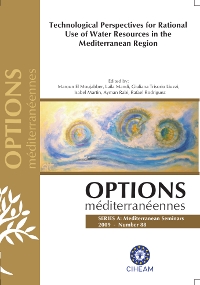| Article précédent | p. 81-87 | Article suivant |
Estimating and monitoring seasonal water consumption of olive orchards in a semi-arid region (Morocco) using the Eddy-covariance system
Accurate measurements of heat and water fluxes are required for optimizing water management and for validating models simulating crop water consumption. For the olive orchard, which is the dominant crop in Mediterranean regions, very little information exists on the exchange of heat and water fluxes between the vegetation and the atmosphere. In the context of SUDMED project, an experimental setup was conceived to monitor seasonal water consumption of olive orchards located near Marrakech, Morocco. For this purpose, an Eddy-Covariance (EC) system, a meteorological station, as well as measurements of soil moisture and temperature were continuously operated during more than one year over an irrigated olive yard, i.e. tall, sparse vegetation. The total annual rainfall and irrigation amount were around 354 and 800 mm respectively. The yearly cumulative evapotranspiration measured from eddy-covariance system was 824 mm. By using the water balance equation, the result showed also that a large quantity of water (around 330 mm) was lost due to deep percolation, infiltration and runoff. This loss is essentially due to the irrigation method (flood) which has an irregular pattern in space and time. On the other hand, the water requirements calculated following the FAO-56 procedure were 920 mm. Although the sum of irrigation and rainfall was greater than ETc, the stress event occurred. Such behaviour can be explained by the fact that the irrigation monitoring is done by observing the physical conditions of the plant which is not sufficient to manage the irrigation.
La mesure correcte de la chaleur et des flux hydriques est indispensable pour optimiser la gestion de l'eau et valider les modèles qui simulent la consommation d'eau pour les différentes cultures. Pour l'olivier, qui est la culture dominante en Méditerranée, les informations sur l'échange de chaleur et les flux hydriques entre la végétation et l'atmosphère restent insuffisantes. Par conséquent, dans le cadre du projet SUDMED, un dessein expérimental a été mis au point pour suivre la consommation saisonnière d'eau dans les vergers d'oliviers de la zone autour de Marrakech, au Maroc. A cette fin, la méthode covariance turbulence a été appliquée. Des données météorologiques, des mesures de l'humidité du sol et de la température ont été suivies pendant plus d'un an sur un couvert végétal clairsemé et développé en hauteur. Au total, les précipitations annuelles et la quantité d'eau apportée par l'irrigation ont été estimées à 354 et 800 mm, respectivement. L'évapotranspiration cumulative annuelle, mesurée par la méthode covariance turbulence, était égale à 824 mm. Les résultats obtenus en appliquant l'équation du bilan hydrique, ont montré qu'une grande partie de l'eau (environ 330 mm) était perdue à cause des effets de la percolation profonde, de l'infiltration et du ruissellement. Ces pertes étaient essentiellement imputables à la méthode d'irrigation (par déversement) utilisée qui suivait un cours irrégulier dans l'espace et dans le temps. Par ailleurs, les besoins en eau estimés par la procédure FAO-56 s'élevaient à 920 mm. Bien que l'eau d'irrigation et les précipitations ensemble soient plus élevées qu' ETc, un problème de stress est intervenu. Un tel phénomène peut être expliqué par le fait que le suivi de l'irrigation a été réalisé en n'observant que les conditions physiques de la plante, ce qui n'est pas du tout suffisant pour gérer l'irrigation.
- [ Afficher ]
- [ Télécharger ]
- [ Exporter la citation ]
Vous pouvez télécharger la citation au format :
- [ Imprimer ]
-
Mots-clés
EVALUATION, EVAPOTRANSPIRATION, IRRIGATION PAR RUISSELLEMENT, MAROC, METHODE STATISTIQUE, OLEA EUROPAEA, RELATION PLANTE EAUCiter cet article
Ezzahar J., Chehbouni A., Er-Raki S., Khabba S., Hanich L. Estimating and monitoring seasonal water consumption of olive orchards in a semi-arid region (Morocco) using the Eddy-covariance system. In : El Moujabber M. (ed.), Mandi L. (ed.), Trisorio-Liuzzi G. (ed.), Martín I. (ed.), Rabi A. (ed.), Rodríguez R. (ed.). Technological perspectives for rational use of water resources in the Mediterranean region. Bari : CIHEAM, 2009. p. 81-87. (Options Méditerranéennes : Série A. Séminaires Méditerranéens; n. 88). 2. MELIA Workshop Technological Perspectives for Rational Use of Water Resources in the Mediterranean Region, 2008/10/29-2008/11/02, Marrakesh (Morocco). http://om.ciheam.org/om/pdf/a88/00801182.pdf



